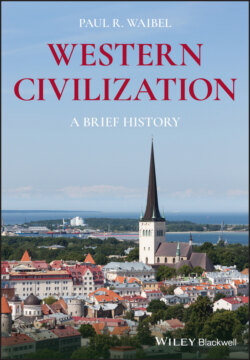Читать книгу Western Civilization - Paul R. Waibel - Страница 47
Part II Europe in the Middle Ages: An Overview
ОглавлениеWhen the last Roman Emperor in the West was deposed in 476, any semblance of central government vanished with him. A plurality of Germanic kingdoms replaced what was the Roman Empire in the West. By the beginning of the ninth century, a strong Frankish kingdom appeared to be assuming the role of the former Roman imperial authority. Charlemagne was crowned Emperor of the Romans by Pope Leo III on Christmas Day, 800. Charlemagne unified much of what today comprises France, the Low Countries, Germany, and Italy down to Rome.
Charlemagne established a palace school at his court in Aachen (Aix la Chapelle) that is credited with stimulating a revival of learning known as the Carolingian Renaissance. The Frankish Kingdom fragmented following Charlemagne’s death in 814. The successor kingdoms were unable to provide protection from the Viking raids during the ninth century. The need to provide for law and order and livelihood at the local level in the absence of any central government gave rise to feudalism. A feudal pyramid with the king at its peak and levels of warrior nobility owing personal loyalty to one another in exchange for land emerged throughout Europe.
The legacy, or myth, of a universal Christian empire was kept alive by the emergence of a Western Christian faith unified theologically and with a governmental administration centered in Rome. Where there was once an emperor, there was now a pope, and where there was once a Roman civil administration, there were archbishops, bishops, priests, and monastic abbots, all answerable to the bishop of Rome, the successor of St. Peter and vicar of Christ on earth. The people looked to the church for guidance more than to any secular feudal lord.
During the High Middle Ages, the eleventh through thirteenth centuries, central political authority began to reappear in the form of feudal monarchies in England, France, and the Holy Roman Empire, where the imperial title was revived after 961. A thirteenth‐century Renaissance created a synthesis of the Judeo‐Christian religious tradition with Classical Humanism and the Germanic traditions resulting in what became known as Western Civilization.
